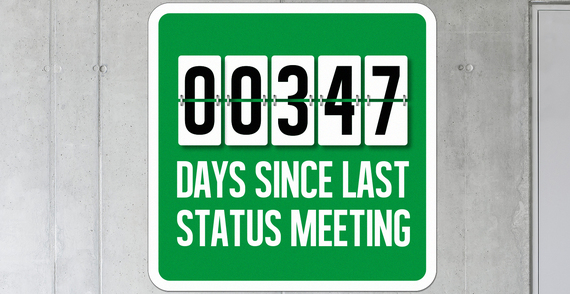Toe tag it. Time of death: 2014. Cause: A thousand paper cuts.
The real mystery here isn't what killed the status meeting, or even who killed it (smart money is on those meddling millennials), but rather how something so universally reviled could have survived as long as it did.
As the workplace has transformed into something that more closely resembles The Social Network than it does Office Space, and companies far afield from tech-land adopt dogmas of "disruption" and "innovation," too many managers cling to the archaic ritual of the status meeting. Why? Status quo. Because that's how things have always been done, and there's no need to fix what isn't broken.
Meanwhile, too few companies empower rank-and-file staffers to challenge dated practices and uproot legacy behavior. Lest we go down that well-worn path of technology acting as a generational divide in today's workplace, I will say, unequivocally, that there's simply no substitute for human-to-human interaction. No productivity app or enterprise social network will ever supplant the collective energy and creativity that happens when people get together in person to collaborate. Not only is it the basis for consistent success, but it also makes the journey a hell of a lot more fun.
Problem is, most status meetings are held for informational purposes, or worse yet, for political gerrymandering. Precious time is wasted regurgitating what everyone -- the key players anyway -- already knows, while the onlookers daydream through the white noise of updates that have no bearing on their day-to-day. On the rare occasion that real issues are surfaced, they're done so in the absence of proposed solutions, recommended actions, or even a forum for participatory decision making.
The status meeting begins predictably. After the chronically late guy ambles in ten minutes past the scheduled start, making no attempt to conceal his still-steaming latte, and just before the offsite team aborts a series of failed attempts to call in, the majordomo calls the meeting to order. "Alright, let's use the remaining fifty minutes to get us all on the same page." Ironically, said page is an actual page in front of everyone; it's the status report that's been dutifully updated and distributed in advance of the meeting, making the table read a superfluous exercise in time suck.
It usually ends the same way, too. Twenty minutes late, after the stale bagels have been picked over, the team shuffles out, drained and uninspired, avoiding eye contact by scrolling through the countless emails, texts, calls, and messages they legitimately missed during the meeting. In the end, a lot was said, a few things even discussed, but little, if anything, was actually advanced. Sound broken to you?
The good news for productivity, not to mention employee sanity, is that there's no shortage of alternatives to keep team members updated in the post-status workplace. From enterprise social networks, internal wikis, IM, and private chat to the old-fashioned email punch list or daily stand-up scrum, you can bolt together a combination of tools - online and offline - to align with the idiosyncrasies of your business.
If pulling the plug on status meetings altogether isn't an option, below are some guidelines on how to make them less execrable as you slowly euthanize the practice.
1. Start by cutting the time in half. If you can cover the same ground in that truncated window, cut it in half again. Whenever possible, cap the meeting at half an hour. Start on time, with military precision, and if someone shows up late, even if it's the boss, keep moving full speed ahead. And end a few minutes early.
2. Next, cut the attendees. And not with a scalpel - with a machete. Keep the list small, fluid, and limited to stakeholders who are directly accountable for the outcome. Rotate in fresh players for perspective, and encourage everyone to challenge one another, take criticism, and listen to alternative points of view.
3. Avoid using it as a clearinghouse for decision-making. We're competing in an always-on marketplace, where issues are surfaced constantly, options weighed quickly, and decisions made in real-time. Hold off on taking action until you get consensus at your standing meeting, and you may be a day late.
4. Finally, foster human conversation. Put a hard embargo on presentation decks and standardized reports, and start encouraging rigorous discourse. Include stimulus as needed, but focus the room's energy on generating new ideas, identifying new opportunities, and making forward progress.
At Omelet, we had to first acknowledge the fatigue and cynicism that low-value meetings foster before we could unlearn our bad meeting habits. We then decentralized meeting protocol, empowering each cross-disciplinary team to prototype its own model, ensuring that each client or project is serviced uniquely. And while meetings are now treated as the exception, rather than the rule, this transformation is still a work in progress; one that we have to vigilantly self-govern every day to ward off the inevitable meeting creep.
As a creative agency, we thrive by constantly outthinking our competitors. We come to work every day with the attitude that we need to keep the ideas flowing to keep the lights on. And that nothing should stand in the way of, or slow down, our thinking. Interrupting the unpredictable rhythm of the ideation process with unnecessary meetings, and forcing creative reasoning into one-or-two-hour increments, is kryptonite for next-generation companies like ours.
So go ahead and put that status meeting out to pasture, and free up your talent's time so they can get back to the business of pushing your business forward.
